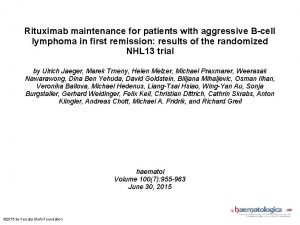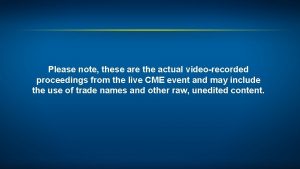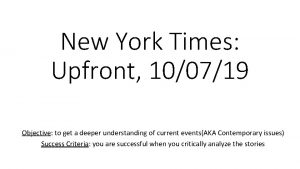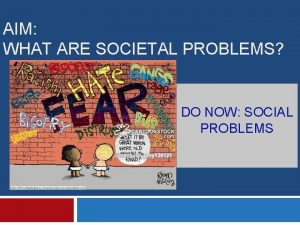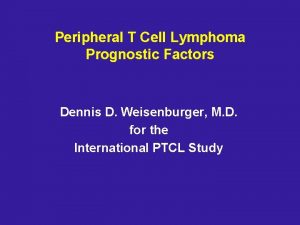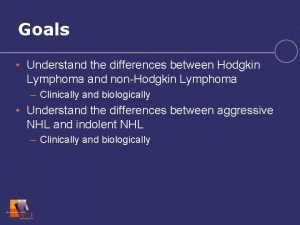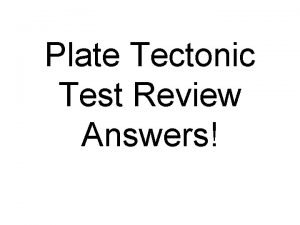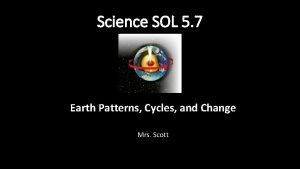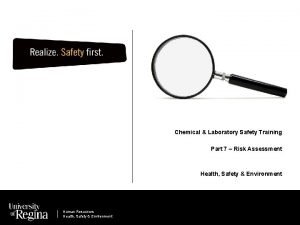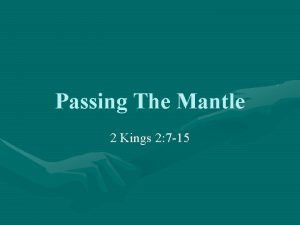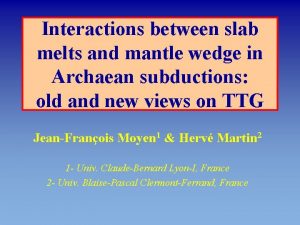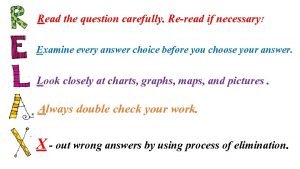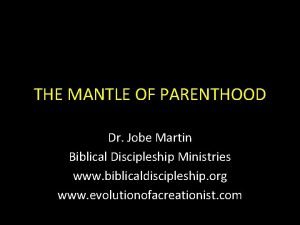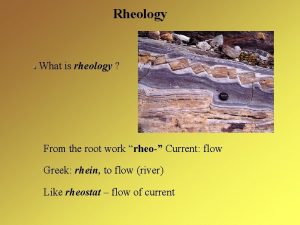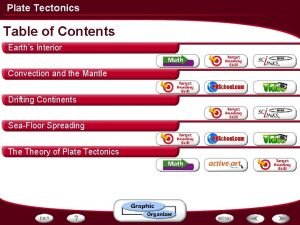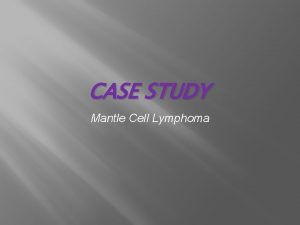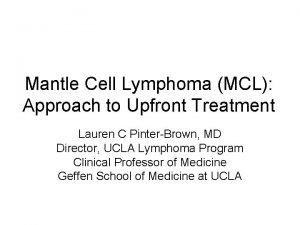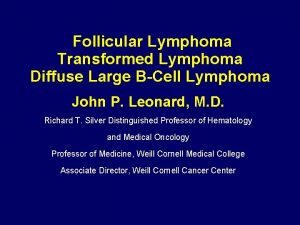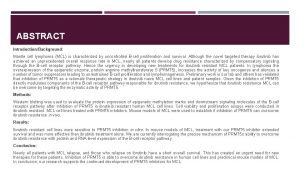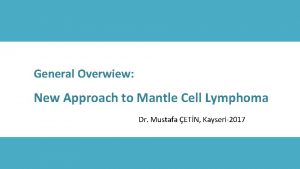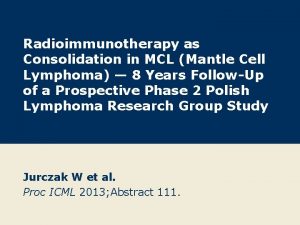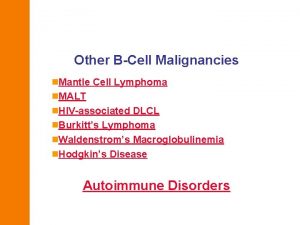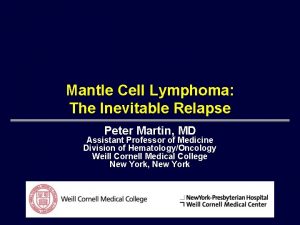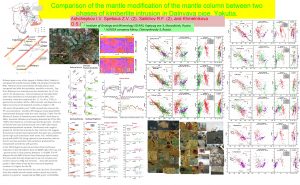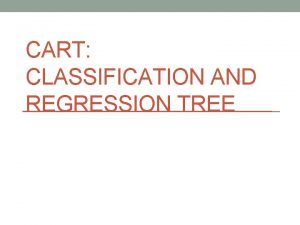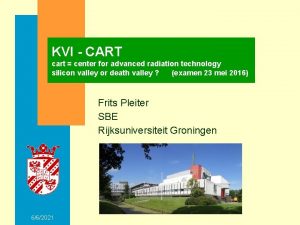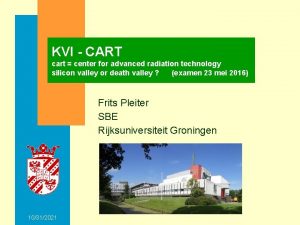Lymphoma Upfront CART for highrisk mantle cell lymphoma














![External Review & Online Feedback External Expert Reviewers: Reviewer #1 • [This is] an External Review & Online Feedback External Expert Reviewers: Reviewer #1 • [This is] an](https://slidetodoc.com/presentation_image_h2/366e1d891ebff31c121a0a37f1f1289f/image-15.jpg)











![External Review & Online Feedback External Expert Reviewers: Reviewer #1 • [An] area of External Review & Online Feedback External Expert Reviewers: Reviewer #1 • [An] area of](https://slidetodoc.com/presentation_image_h2/366e1d891ebff31c121a0a37f1f1289f/image-27.jpg)



- Slides: 30

Lymphoma: • Upfront CAR-T for high-risk mantle cell lymphoma • Consolidation for CAR-T incomplete responders in Diffuse Large B Cell Lymphoma Frederick L. Locke, MD

Conflict of Interest Disclosure Frederick L. Locke: • Scientific Advisory Role: Allogene, Amgen, Bluebird Bio, BMS/Celgene, Cellular Bio. Medicine Group Inc, Calibr, Gamma. Delta Therapeutics, Iovance, Janssen, Legend Biotech, Novartis, Wugen • Research Funding: Kite Pharma (Institutional), Allogene (Institutional), Novartis (Institutional) • Unlicensed patents in the filed of Cellular Immunotherapy. 2

Committee Members Committee Chair Frederick L. Locke, MD Sairah Ahmed, MD Farrukh Awan, MD Study Design Cmte. Rep. Amer M. Beitinjaneh, MD Elizabeth Budde, MD, Ph. D Nilanjan Ghosh, MD, Ph. D Data Center Liaison Mehdi Hamadani, MD Brian Hill, MD, Ph. D Matthew Lunning, DO David G. Maloney, MD, Ph. D Craig Sauter, MD Patrick Stiff, MD Jakub Svoboda, MD Moffitt Cancer Center MD Anderson Cancer Center University of Texas Southwestern University of Miami City of Hope Levine Cancer Institute Medical College of Wisconsin Cleveland Clinic University of Nebraska Medical Center Fred Hutch Memorial Sloan-Kettering Cancer Center Loyola University Medical Center University of Pennsylvania Support provided by grants #U 10 HL 069294 and #U 24 HL 138660 to the Blood and Marrow Transplant Clinical Trials Network from the National Heart, Lung, and Blood Institute and the National Cancer Institute. The content is solely the responsibility of the authors and does not necessarily represent the official views of the National Institutes of Health. 3

Proposed Study Concepts • Upfront CAR-T for high-risk mantle cell lymphoma • Autologous Transplantation in CD 30+ Peripheral T-cell Lymphoma • Consolidation for CAR-T incomplete responders in Diffuse Large B Cell Lymphoma (DLBCL) • Improving outcomes in partially chemo-responsive relapsed/refractory DLBCL 4

Proposed Study Concepts • Upfront CAR-T for high-risk mantle cell lymphoma • Autologous Transplantation in CD 30+ Peripheral T-cell Lymphoma • Consolidation for CAR-T incomplete responders in Diffuse Large B Cell Lymphoma (DLBCL) • Improving outcomes in partially chemo-responsive relapsed/refractory DLBCL 5

Upfront CAR-T for high-risk mantle cell lymphoma (MCL) Hypothesis: CD 19 chimeric antigen receptor T cell therapy (CAR-T) as frontline, after lead-in immunotherapy, will safely improve progression-free survival (PFS) in ultra-high-risk (UHR) MCL. 6

Upfront CAR-T for high-risk mantle cell lymphoma (MCL) Hypothesis: CD 19 chimeric antigen receptor T cell therapy (CAR-T) as frontline, after lead-in immunotherapy, will safely improve progression-free survival (PFS) in ultra-high-risk (UHR) MCL. Trial Concept: Phase II trial of CAR-T after novel BTKi-based lead-in as frontline therapy for ultra-high-risk (UHR) MCL. 7

Background & Significance 2 -year PFS ranges from 20 -50% in MCL patients with adverse-risk features 1: • High International Prognostic Index (MIPI) and high-intermediate/high MIPI-c 2 -year PFS 30 -50% 2 • TP 53 mutation 2 -year PFS 20% 3 • Chromosomal 17 p deletions 2 -year PFS 50% 3 • Complex karyotype 2 -year PFS 45% 4 • Blastoid histology 2 -year PFS 45% 2 1. Maddocks. Blood 2019 ; 2. Hoster E. JCO 2016; 3. Eskelund C. Blood 2017; 4. Greenwell I. Cancer. 2018 8

Background & Significance 2 -year PFS ranges from 20 -50% in MCL patients with adverse-risk features 1: • High International Prognostic Index (MIPI) and high-intermediate/high MIPI-c 2 -year PFS 30 -50% 2 • TP 53 mutation 2 -year PFS 20% 3 • Chromosomal 17 p deletions 2 -year PFS 50% 3 • Complex karyotype 2 -year PFS 45% 4 • Blastoid histology 2 -year PFS 45% 2 1. Maddocks. Blood 2019 ; 2. Hoster E. JCO 2016; 3. Eskelund C. Blood 2017; 4. Greenwell I. Cancer. 2018 9

Background & Significance 2 -year PFS ranges from 20 -50% in MCL patients with adverse-risk features 1: • High International Prognostic Index (MIPI) and high-intermediate/high MIPI-c 2 -year PFS 30 -50% 2 • TP 53 mutation 2 -year PFS 20% 3 • Chromosomal 17 p deletions Newly diagnosed MCL patients w/ ultrahigh-risk features have dismal outcomes 2 -year PFS 50% 3 • Complex karyotype 2 -year PFS 45% 4 New therapies and approaches are desperately needed to improve outcomes • Blastoid histology 2 -year PFS 45% 2 1. Maddocks. Blood 2019 ; 2. Hoster E. JCO 2016; 3. Eskelund C. Blood 2017; 4. Greenwell I. Cancer. 2018 10

Background & Significance • Brexucabtagene autoleucel CD 19 -CAR-T demonstrated remarkable efficacy in refractory MCL patients that previously received BTKi. • • 92% ORR 67% CR 61% 12 -month PFS 59% 15 -month PFS 1. Wang N. NEJM 2021 11

Trial Design • Single arm phase II trial for UHR MCL evaluating front-line CD 19 -CAR-T after lead-in of BTKi+/-rituximab. • Before enrollment, <=2 standard induction cycles are permitted. • Primary endpoint: 2 -year PFS from enrollment. • Secondary endpoints: Adverse events; OS; ORR; Achievement of MRD; Apheresis and CAR-T phenotype; CAR-T levels in the blood High-risk MCL Registered after meeting study eligibility BTKi +/- rituximab 4 – 6 cycles Apheresis +/- bridging Flu/Cy LD CAR-T Follow up: Relapse/progression MRD monitoring 12

Trial Design: Options or Alternatives • For consideration: • Patients with MRD receive BTKi maintenance. • Alternative Designs: • Randomized phase II against best available care in frontline • CAR-T consolidation following standard induction as a phase 2 and then compared in a randomized phase III against induction followed by ASCT in responders. 13

Feasibility & Logistics • 2 -year PFS, based upon historical controls, is estimated to be 45% • We estimate this approach could increase 2 -year PFS to 65% • 54 patients are needed to detect 20% improvement, with 90% power and onesided 0. 05 alpha for an exact-binomial test. • For interim monitoring, sample size is inflated to 60. • 18 -month accrual and 24 -month follow-up is estimated. • CAR-T manufacturer support is required: several are interested to pursue upfront MCL indications. • BTKi may garner industry support given the crowded market. 14
![External Review Online Feedback External Expert Reviewers Reviewer 1 This is an External Review & Online Feedback External Expert Reviewers: Reviewer #1 • [This is] an](https://slidetodoc.com/presentation_image_h2/366e1d891ebff31c121a0a37f1f1289f/image-15.jpg)
External Review & Online Feedback External Expert Reviewers: Reviewer #1 • [This is] an area of significant unmet need. The key will be an appropriate definition of high risk. Could definitely change practice and would need a network to complete a trial like this. • In theory, industry could do a trial like this, so that would be the only weakness. 15

External Review & Online Feedback External Expert Reviewers: Reviewer #2 • This is a very important question, as we now can better define high risk MCL, and we know that standard therapy is not adequate in this situation. • My major concern with the proposed design is the single arm nature of this proposal. In CLL, high risk predictive markers in the setting of chemoimmunotherapy do not hold when novel agents such as BTK inhibitors are utilized. The same situation could be true for MCL. • ECOG as well as the German Mantle Cell Consortium are studying non chemotherapy regimens in this setting. I would strongly endorse a randomized design where CAR-T is one arm, and the other arm would include other alternatives to chemotherapy. • The other issue with this trial is that the majority of patients with high risk mantle cell lymphoma are older and may not be eligible for CAR-T. 16

External Review & Online Feedback: • I think bifunctional antibodies are going to be cheaper, easier, and at least as effective as CART - why not go with mosunetuzumab or RGN 1979 instead and CART if it fails • Patient specific CAR T products may be replaced by allo products so this is modest set of proposals • The concept of bringing CAR T into the frontline therapy of high risk MCL is clinically very interesting. • Concerns would be if the patients develop prolonged cytopenias after CAR T - would this affect collection ability at later time point ? • It may be more reasonable to do MCL CAR T cell therapy as true second line instead of salvage plus auto, similar as this is being done for JCAR 17 for DLBCL. 17

External Review & Online Feedback (Continued): • Could be improved either by randomization or change the primary endpoint to CR rate. PFS in single arm is non interpretable • [The] Concept is good but needs a strong comparison group - eg concurrent controls from eg the CIBMTR database or other database 18

Consolidation for CAR-T incomplete responders in Diffuse Large B Cell Lymphoma (DLBCL) Hypothesis: Consolidation therapy will improve PFS for DLBCL patients at high risk for progression following first disease assessment after CAR-T. 19

Consolidation for CAR-T incomplete responders in Diffuse Large B Cell Lymphoma (DLBCL) Hypothesis: Consolidation therapy will improve PFS for DLBCL patients at high risk for progression following first disease assessment after CAR-T. Trial Concept: A randomized trial evaluating immunotherapy consolidation in DLBCL with stable disease (SD) or partial remission (PR) on first imaging after CD 19 -CAR-T. 20

Background & Significance • Autologous CD 19 directed CAR-T cell therapy leads to remarkable durable response rates in relapsed and refractory DLBCL. • The majority of patients progress after CAR-T. 1. Locke. Lancet Oncology 2018; 2. Locke. JAMA Oncology 2020. 21

Background & Significance • Responses are highly dynamic in the first 90 days after CAR-T. • Ongoing response at day 90 is associated with durable response beyond 1 year. 1. Locke. Lancet Oncology 2018; 22

Background & Significance • 65 -75% of DLBCL patients with PR, and 90 -95% with SD, on day+28 PET-CT scan after CAR-T will ultimately progress by 1 -year. 1 -4 • This group comprises ~40% of CAR-T patients and as responses can deepen, observation is the current standard. 1. 2. 3. 4. Neelapu SS, NEJM 2017 Schuster S, NEJM 2019 Abramson JS, Lancet 2021 Nastoupil L, JCO 2020 23

Background & Significance • 65 -75% of DLBCL patients with PR, and 90 -95% with SD, on day+28 PET-CT scan after CAR-T will ultimately progress by 1 -year. 1 -4 • This group comprises ~40% of CAR-T patients and as responses can deepen, observation is the current standard. • MRD monitoring at day+28 may identify those destined to progress. 5 1. 2. 3. 4. 5. Neelapu SS, NEJM 2017 Schuster S, NEJM 2019 Abramson JS, Lancet 2021 Nastoupil L, JCO 2020 Hossain NM, ASH 2019 #609 24

Trial Design • Phase II randomized 3 -arm study evaluates 6 -months of tafasitamab+ lenalidomide or polotuzumab+ mosunetuzumab*, compared to observation, for incomplete responders to commercial CAR-T at Day+28 by PET-CT. • Patients are randomized following the day+28 PET. • Primary endpoint: 1 -year PFS after randomization. • Secondary endpoints: CR rate, OS, MRD assay progression predictability, and CAR-T persistence. • An alternate design may allow enrollment prior to day+28, and patients achieving CR are monitored for MRD. *Alternative agents and combinations could be considered. 25

Feasibility & Logistics • After CD 19 -CAR-T, 5% of SD and 30% of PR patients at day+28 will be in remission at day+90, and only 75% of those will persist at 1 year. • 57 patients per arm must be randomized to detect an increase in aggregate 1 year PFS from 20% to 40% using Fisher’s Exact test with 80% power and a one-sided 10% alpha for each comparison against the standard arm. • Patients relapsing after CAR-T have dismal outcomes and pharmaceutical companies are enthusiastic to demonstrate efficacy in this population. 26
![External Review Online Feedback External Expert Reviewers Reviewer 1 An area of External Review & Online Feedback External Expert Reviewers: Reviewer #1 • [An] area of](https://slidetodoc.com/presentation_image_h2/366e1d891ebff31c121a0a37f1f1289f/image-27.jpg)
External Review & Online Feedback External Expert Reviewers: Reviewer #1 • [An] area of high unmet need and I think it would be well received at academic sites. Several good interventions that could be contemplated. Would enroll well. Reviewer #2 • This is a very important area and has direct potential to change practice. • Given the rarity of this scenario, it would require a multicenter network study to be done effectively. • There are current discussions about this approach in the NCTN. • … to succeed, it will be important to have broad by-in on the experimental arms. 27

External Review & Online Feedback : • The concept is certainly meaningful and already being practiced off label at different places, often trying lenalidomide or check point inhibitor off label if approved and paid for. • Would there be concerns with tolerability - especially from a marrow suppressive point of view for the tafa/rev arm? • polotuzumab+ mosunetuzumab - not sure if this is approved already in this combination and if this has been shown to be safe, study design would depend on this 28

Q&A Session 29

30
 Maintenance rituximab mantle cell lymphoma
Maintenance rituximab mantle cell lymphoma Rbac mantle cell lymphoma
Rbac mantle cell lymphoma New york times upfront
New york times upfront Upfront scholastic
Upfront scholastic Hepatosplenic t-cell lymphoma
Hepatosplenic t-cell lymphoma Diff between hodgkin and non hodgkin
Diff between hodgkin and non hodgkin Stiffer mantle definition
Stiffer mantle definition Mantle magma
Mantle magma Throw your hands up for the layers of the earth
Throw your hands up for the layers of the earth The call of elisha
The call of elisha Continental drift theory notes
Continental drift theory notes Core crust mantle
Core crust mantle Mantle magma
Mantle magma Mantle made of
Mantle made of Heating mantle risk assessment
Heating mantle risk assessment Pass the mantle
Pass the mantle Earth mantle
Earth mantle Mantle wedge
Mantle wedge What best describes the mantle of earth
What best describes the mantle of earth Mantle convection diagram
Mantle convection diagram Mantle biblical definition
Mantle biblical definition The boundary between the mantle and core
The boundary between the mantle and core Mantle meaning geography
Mantle meaning geography Mantle made of
Mantle made of Layers of the earth rap
Layers of the earth rap Earth's mantle
Earth's mantle Core mantle crust
Core mantle crust Crust mantle core
Crust mantle core Seafloor spreading material at trenches
Seafloor spreading material at trenches Structures of the earth
Structures of the earth The layers of an egg
The layers of an egg
